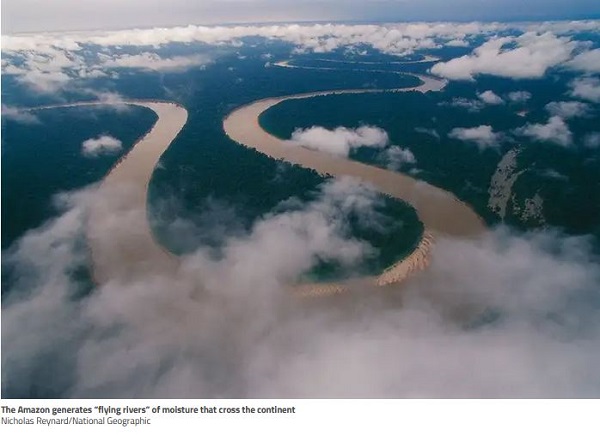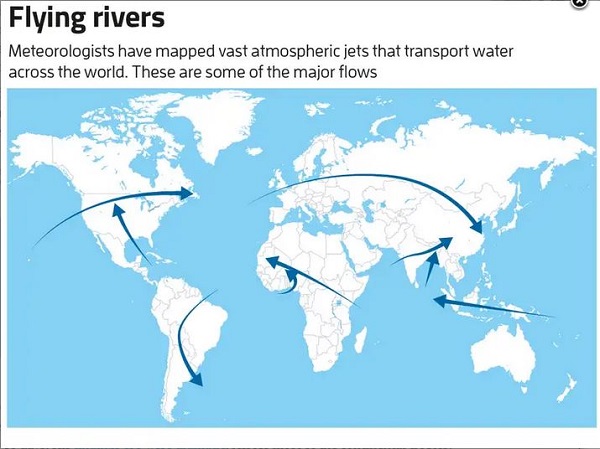
Transpiration is a process whereby trees take water from the soil and release it into the air. The effect is immense and under-appreciated according to an article in the New Scientist by Fred Pearce.
Transpiration is responsible for around half of all precipitation, up to 60,000 cubic kilometres of water per year, more water than all the world’s rivers combined.
In the Amazon, for example, 400 billion trees or so circulate water into the air five or six times. Isotopic analysis has revealed that the water supply for Sao Paulo’s 20 million people mostly comes from rainforest.
If the Amazon turned into desert the effects would be felt as far away as Argentina and right up into central USA.
A recent study has found that deforestation has reduced regional rainfall by as much as 40% per annum.
Key source regions include western North America, eastern Africa, Europe, western Asia, India and, above all, the Brazilian Amazon. Flying rivers often take this water long distances. Around 70 per cent of the water in the River Plate basin, which stretches from southern Brazil through Bolivia, Paraguay and Uruguay to Buenos Aires in Argentina, comes from transpiration in the Amazon. China gets the moisture for over 80 per cent of its rain from far to the west in the forests of Siberia and Scandinavia, a journey involving several stages of water recycling by trees and taking six months or more.
“The China finding was among my first, and it was a real eye-opener,” says van der Ent. “We learn in high school that rainfall comes from the oceans. China is next to an ocean, yet most of its rainfall is moisture recycled from the land far to the west.”
This map shows some of the main rivers in the sky.

Australia does not show up there, perhaps because the river has run dry. The text actually targets the impact of early human intervention:
It was much wetter until around 45,000 years ago. Today’s desert depressions were huge permanent lakes, kept full by strong and wet monsoon winds. Lake Eyre, also known as Kati Thanda, back then extended to around 10,000 square kilometres, but is now usually a dry salt-encrusted plain.
Also it says:
In the past half century, some 130,000 square kilometres of forest along the western coast south of Perth has been replaced by wheat fields. While rainfall along the coast has remained stable, there has been a 20 per cent decline inland, leaving reservoirs that supply Perth parched, says Jorg Imberger, former director of the Centre for Water Research at the University of Western Australia.
Water management needs to take a broader view. One study looked at planting 70,000 square kilometres of extra forest in the Bolivian Amazon to deliver 600 million cubic metres of extra rain annually to a river supplying the country’s largest city, Santa Cruz.
Some species transpire more than others. An inconvenient finding is that palm oil and rubber trees can transpire more than the trees they replace.
For the Amazon a reduction of 20 to 25 per cent forest cover may be the tipping point which converts the region into open savannah. Africa may be in even more peril with the source of the Nile and jungles of Central Africa.
